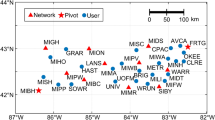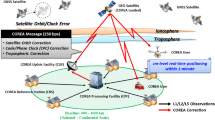Abstract
The limitation of single base “real-time kinematic” (RTK) techniques is the distance between base receiver and the rover receiver due to distance-dependent biases, namely orbit bias, ionosphere bias and troposphere bias. Techniques have been developed to overcome this distance dependence using a network of GPS reference stations spread over a wide geographic area. Because the measurement biases will be modelled and corrected for, the positioning accuracy will be almost independent of the inter-receiver distance. Since the mid-1990s investigators have been investigating the optimal means of processing reference receiver data, and then providing ‘correction’ information to users, in real-time. This technique is now generally referred to as Network-RTK. In 1993 the International Association of Geodesy (IAG) established a Special Study Group on “Wide Area Modelling for Precise Satellite Positioning” . This paper focusses on the progress made during the last few years in designing Network-RTK architectures and the associated data processing algorithms and issues. Although many university investigators have been researching the fundamental challenges in functional and stochastic modelling, currently there is only one commercially available Network-RTK product, the Trimble VRS. However, with the use of the Internet as the primary data communication link, it is predicted that many more implementations of Network-RTK will come ‘online’, at various sites around the world, over the next few years.
Similar content being viewed by others
References
Blewitt G. Carrier Phase Ambiguity Resolution for the Global Positioning System Applied to Geodetic Baselines up to 2000 km,Journal of Geophysical Research, 1989,94(B8): 10187–10203.
Dong D N, Bock Y. Global Positioning System Network Analysis with Phase Ambiguity Resolution Applied to Crustal Deformation Studies in California,Journal of Geophysical Research, 1989,94(B4): 3949–3966.
Han S, Rizos C. GPS Network Design and Error Mitigation for Real-time Continuous Array Monitoring Systems.9th Int Tech Meeting of the Satellite Div of the U S Institute of Navigation, Kansas City, Missouri, 17–20 September, Alexandria: US ION, 1996: 1827–1836.
Wübbena G, Bagge A, Seeber G,et al. Reducing Distance Dependent Errors for Real-Time Precise DGPS Applications by Establishing Reference Station Networks.9th Int Tech Meeting of the Satellite Div of the U.S. Institute of Navigation, Kansas City, Missouri, 17–20 September, Alexandria: US ION, 1996: 1845–1852.
Han S.Carrier Phase-Based hong-Range GPS Kinematic Positioning, Sydney: The University of New South Wales. 1997.
Raquet J F, Lachapelle G, Fortes L. Use of a Covariance Analysis Technique for Predicting Performance of Regional Area Differential Code and Carrier-Phase Networks.11th Int Tech Meeting of the Satellite Div. of the U S Institute of Navigation, Nashville, Tennessee, Alexandria: US ION, 1998. 1345–1354.
Vollath U, Buecherl A, Landau H. Multi-Base RTK Positioning Using Virtual Reference Stations.13th Int Tech Meeting of the Satellite Div of the U S Institute of Navigation, Salt Lake City, Utah, 19–22 September, Alexandria: US ION, 2000. 123–131.
Townsend B, VanDierendonck A J, Neumann J,et al. A Proposal for Standardized Network RTK Messages.13th Int Tech Meeting of the Satellite Div of the U S Institute of Navigation, Salt Lake City, Utah, 19-22 September, Alexandria: US ION, 2000. 1871–1878.
Euler H J, Keenan C R, Zebhauser B E,et al. Study of a Simplified Approach in Utilizing Information from Permanent Reference Station Arrays.14th Int Tech Meeting of the Satellite Div of the U.S. Institute of Navigation, Salt Lake City, Utah, 11–14 September, Alexandria: US ION, 2001. 379–391.
Hu G, Khoo H S, Goh P C,et al. Testing of Singapore Integrated Multiple Reference Station Network (SIMRSN) for Precise Fast Static Positioning.European GNSS Conf GNSS2002, Copenhagen, Denmark, 27–30 May, CD-ROM proc. 2002.
Jia M. Mitigation of Systematic Errors of GPS Positioning Using Vector Semiparametric Models.13th Int Tech Meeting of the Satellite Div of the U S Institute of Navigation, Salt Lake City, Utah, 19–22 September, Alexandria: US ION, 2000. 1938–1947.
Ge L, Han S, Rizos C. Multipath Mitigation Using an Adaptive Filter.GPS Solutions, 2000,4(2): 19–30.
Santerre R, Langley RB, Ueno M,et al. Improvement of Kinematic OTF-GPS Positioning Over Long Distances: Applications to Bathymetric Surveys.Canadian Hydrographic Conference 2000, Montréal, Canada, 15–19 May (CD-Rom Proceedings). 2000.
St-Pierre C, Santerre R, Parrot D. Mprovement of OTF-Kinematic GPS Positioning Over Long Distances Using Ionospheric Regional Modelling,Geomatica, Journal of the Canadian Institute of Geomatics, 1999,53(4): 395–403.
Colombo OL, Evans A G, Vigo M I,et al. Long-Baseline (>1000 km), Sub-Decimeter Kinematic Positioning of Buoys at Sea, with Potential Application to Deep-Sea Studies.13th Int Tech Meeting of the Satellite Div of the U.S. Institute of Navigation, Salt Lake City, Utah, 19–22 September, Alexandria: US ION, 2000. 1476–1484.
Dai L, Wang J, Rizos C,et al. Predicting Atmospheric Biases for Real-Time Ambiguity Resolution in GPS/Glonass Reference Stations Networks.Journal of Geodesy, 2003,76: 617–628.
Brunner F K, Hartinger H, Troyer L. GPS Signal Diffraction Modelling: The Stochastic SIGMA-δ Model.Journal of Geodesy, 1999,73: 259–267.
Wieser A, Brunner F K. An Extended Weight Model for GPS Phase Observations,Earth, Planets & Space, 2000,52:777–782.
Barnes J B, Ackroyd N, Cross P A. Stochastic Modelling for Very High Precision Real-time Kinematic GPS in an Engineering Environment.XXI Congress of the International Federation of Surveyors, 6 (ISBN 0-85406-902-X), 1998. 61–76.
[20]Wang J, Satirapod C, Rizos C. Stochastic Assessment of GPS Carrier Phase Measurements for Precise Static Relative Positioning.Journal of Geodesy, 2002,76(2): 95–104.
Han S, Johnson R. Survey Quality Real-Time GPS: Solving the Time to Fix vs. Reliability Paradox,14th lnt Tech Meeting of the Satellite Div of the U S Institute of Navigation, Salt Lake City, Utah, 11–14 September, Alexandria: US ION, 2001. 1550–1557.
Odijk D. Weighting Ionospheric Corrections to Improve Fast GPS Positioning Over Medium Distances:13th lnt Tech. Meeting of the Satellite Div of the Institute of Navigation, Salt Lake City, Utah, 19–22 September, Alexandria: US ION, 2000. 1113–1123.
Chen H Y, Rizos C, Han S. From Simulation to Implementation: Low-Cost Densification of Permanent GPS Networks in Support of Geodetic Applications.Journal of Geodesy, 2001,75(9–10): 515–526.
Gao Y, Li Z, McLellan J F. Carrier Phase Based Regional area Differential GPS for Decimeter-Level Positioning and Navigation,10th lnt Tech Meeting of the Satellite Div of the U S Institute of Navigation, Kansas City, Missouri, 16–19 September, Alexandria: US ION, 1997. 1305–1313.
Gao Y, Li Z. Ionosphere Effect and Modelling for Regional Area Differential GPS Network.11th Int Tech Meeting of the Satellite Div of the U S Institute of Navigation, Nashville, Tennessee, 15–18 September, Alexandria: US ION, 1998. 91–97.
Wanninger L. Improved Ambiguity Resolution by Regional Differential Modelling of the Ionospherez.8th Int Tech Meeting of the Satellite Div of the U S Institute of Navigation, San Diego, California, 12–15 September, Alexandria: US ION, 1995. 55–62.
Wübbena G, Schmitz M, Menge F,et al. Automated Absolute Field Calibration of GPS Antennas in Real-Time.13th Int Tech Meeting of the Satellite Div of the Institute of Navigation, Salt Lake City, Utah, 19–22 September, Alexandria: US ION, 2000. 2512–2522.
Fotopoulos G, Cannon M E. An Overview of Multi-reference Station Methods for Cm-Level Positioning.GPS Solutions, 2001,4(3): 1–10.
Raquet J F.Development Of A Method For Kinematic GPS Carrier-Phase Ambiguity Resolution Using Multiple Reference Receivers, PhD Thesis, Dept. of Geomatics Engineering, University of Calgary, Canada. 1998.
Marel H van der. Virtual GPS Reference Stations in The Netherlands,llth Int Tech Meeting of the Satellite Div of the U S Institute of Navigation, Nashville, Tennessee, 15–18 September, Alexandria: US ION, 1998. 49–58.
Wanninger L. The Performance of Virtual Reference Stations in Active Geodetic GPS-Networks Under Solar Maximum Conditions.12th Int Tech Meeting of the Satellite Div of the U S Institute of Navigation, Nashville, Tennessee, 14–17 September, Alexandria: US ION, 1999. 1419–1427.
Chen X, Han S, Rizos C,et al. Improving Real-Time Positioning Efficiency Using the Singapore Integrated Multiple Reference Station Network (SIMRSN), 13th Int Tech Meeting of the Satellite Div of the U S Institute of Navigation, Salt Lake City, Utah, 19–22 September, Alexandria: US ION, 2000. 9–18.
Fotopoulos G. Parameterization of Carrier Phase Corrections Based on a Regional Network of Reference Stations,13th Int Tech Meeting of the Satellite Div of the U S Institute of Navigation, Salt Lake City, Utah, 19–22 September, Alexandria: US ION, 2000. 1091–1102.
Jackson M E, Meertens C, Ruud O,et al. Real-Time GPS Data Transmission Using VSAT Technology.GPS Solutions, 2002,5(4): 10–19.
Teunissen P J G, de Jonge PJ, Tiberius CCJM. A New Way to Fix Carrier-Phase Ambiguities.GPS World, 1995,6(4): 58–61.
Euler H J, Ziegler C. Advances in Ambiguity Resolution for Surveying Type Applications,13th Int Tech Meeting of the Satellite Div of the U.S. Institute of Navigation, Salt Lake City, Utah, 19–22 September, Alexandria: US ION, 2000. 95–103.
Teunissen PJG, Joosten P, Odijk D. The Reliability of GPS Ambiguity Resolution.GPS Solutions, 1999,2(3): 63–69.
Author information
Authors and Affiliations
Corresponding author
Additional information
Biography: C. Rizos (1954-), male, Professor, Ph.D, research direction: precise static and kinematic applications of GPS.
Rights and permissions
About this article
Cite this article
Rizos, C., Han, S. Reference station network based RTK systems-concepts and progress. Wuhan Univ. J. Nat. Sci. 8, 566–574 (2003). https://doi.org/10.1007/BF02899820
Received:
Issue Date:
DOI: https://doi.org/10.1007/BF02899820




